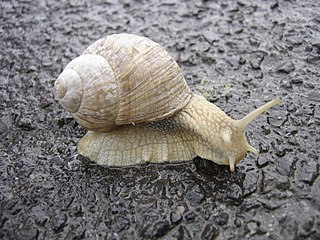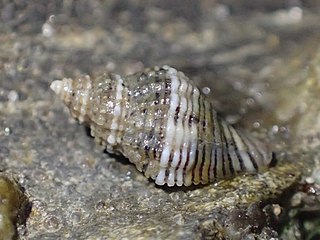
A snail is, in loose terms, a shelled gastropod. The name is most often applied to land snails, terrestrial pulmonate gastropod molluscs. However, the common name snail is also used for most of the members of the molluscan class Gastropoda that have a coiled shell that is large enough for the animal to retract completely into. When the word "snail" is used in this most general sense, it includes not just land snails but also numerous species of sea snails and freshwater snails. Gastropods that naturally lack a shell, or have only an internal shell, are mostly called slugs, and land snails that have only a very small shell are often called semi-slugs.

A seashell or sea shell, also known simply as a shell, is a hard, protective outer layer usually created by an animal that lives in the sea. The shell is part of the body of the animal. Empty seashells are often found washed up on beaches by beachcombers. The shells are empty because the animal has died and the soft parts have decomposed or been eaten by another animal.

The gastropods, commonly known as snails and slugs, belong to a large taxonomic class of invertebrates within the phylum Mollusca called Gastropoda.

Heterobranchia, the heterobranchs, is a taxonomic clade of snails and slugs, which includes marine, aquatic and terrestrial gastropod mollusks.

Whelk is a common name applied to various kinds of sea snail. Although a number of whelks are relatively large and are in the family Buccinidae, the word whelk is also applied to some other marine gastropod species within several families of sea snails that are not very closely related.

A siphon is an anatomical structure which is part of the body of aquatic molluscs in three classes: Gastropoda, Bivalvia and Cephalopoda.

The operculum is a corneous or calcareous anatomical structure like a trapdoor that exists in many groups of sea snails and freshwater snails, and also in a few groups of land snails; the structure is found in some marine and freshwater gastropods, and in a minority of terrestrial gastropods, including the families Helicinidae, Cyclophoridae, Aciculidae, Maizaniidae, Pomatiidae, etc.

Captain Frederick Wollaston Hutton was an English-New Zealand scientist who applied the theory of natural selection to explain the origins and nature of the natural history of New Zealand. An army officer in early life, he then had an academic career in geology and biology. He became one of the most able and prolific nineteenth century naturalists of New Zealand.

Sea snail is a common name for slow-moving marine gastropod molluscs, usually with visible external shells, such as whelk or abalone. They share the taxonomic class Gastropoda with slugs, which are distinguished from snails primarily by the absence of a visible shell.

Cone snails, cone shells, or cones are a large group of small- to large-sized extremely venomous predatory sea snails, marine gastropod molluscs.

A micromollusk is a shelled mollusk which is extremely small, even at full adult size. The word is usually, but not exclusively, applied to marine mollusks, although in addition, numerous species of land snails and freshwater mollusks also reach adult size at very small dimensions.

Ocenebra is a genus of predatory sea snails, marine gastropod mollusks in the subfamily Ocenebrinae of the family Muricidae, the murex and rock snails.

Freshwater snails are gastropod mollusks which live in fresh water. There are many different families. They are found throughout the world in various habitats, ranging from ephemeral pools to the largest lakes, and from small seeps and springs to major rivers. The great majority of freshwater gastropods have a shell, with very few exceptions. Some groups of snails that live in freshwater respire using gills, whereas other groups need to reach the surface to breathe air. In addition, some are amphibious and have both gills and a lung. Most feed on algae, but many are detritivores and some are filter feeders.

Ocinebrina is a genus of sea snails, marine gastropod mollusks in the subfamily Ocenebrinae of the family Muricidae, the murex snails or rock snails.

In the shell of gastropod mollusks, the lip is the free margin of the peristome or aperture of the gastropod shell.
Cocculinella kopua is a species of small, deep water sea snail, a marine gastropod mollusk in the family Cocculinellidae, the limpets.
Tentaoculus lithodicola is a species of small sea snail, a marine gastropod mollusk in the family Pseudococculinidae, the false limpets.

Terrestrial molluscs or land molluscs (mollusks) are an ecological group that includes all molluscs that live on land in contrast to freshwater and marine molluscs. They probably first occurred in the Carboniferous, arising from freshwater ones.

Perimangelia is a genus of sea snails, marine gastropod mollusks in the family Mangeliidae.

Paciocinebrina is a genus of sea snail, a marine gastropod mollusk in the family Muricidae, the murex snails or rock snails.


















